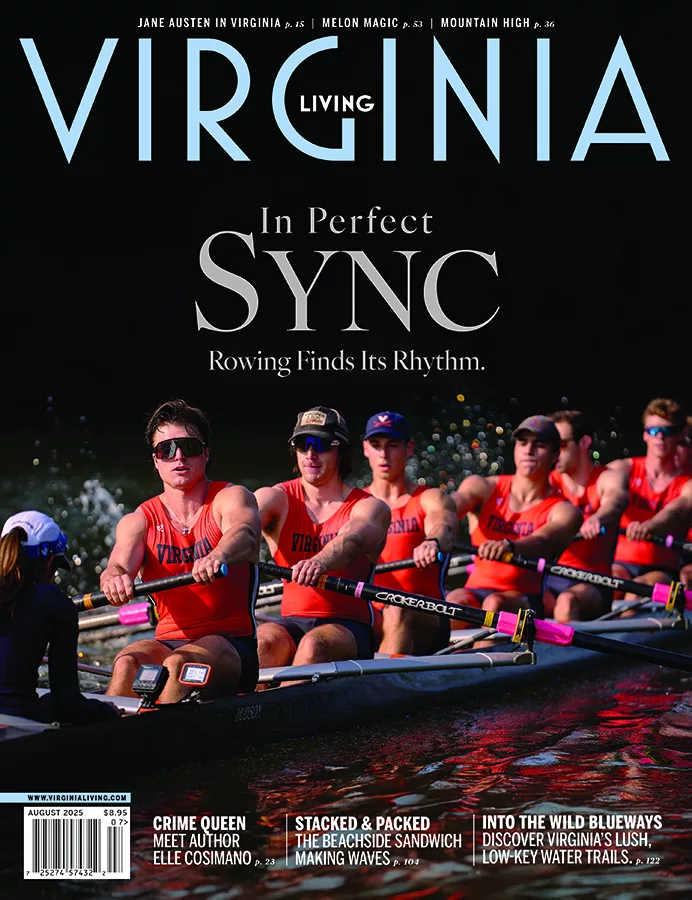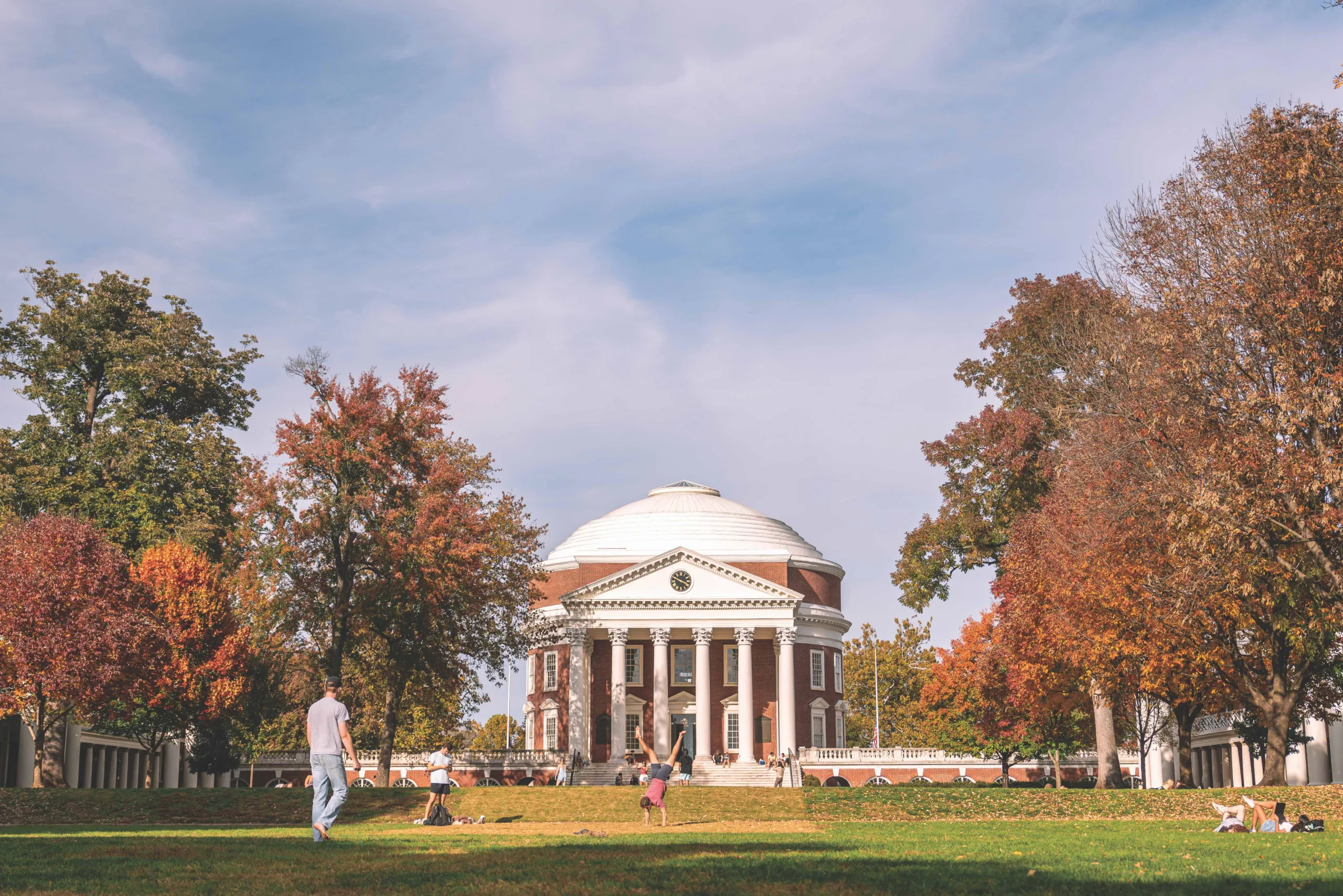A repurposed school bus turns onto a gated gravel road deep in the far Southwest Virginia mountains. It climbs for 10 minutes through dense thickets and woods into a long, grassy meadow with soaring, 360-degree views of the surrounding Allegheny Mountains. We climb higher and higher until the starboard hillside drops away in a stupendous cascade of rounded valleys and hollows that stair through the forested peaks of the Cumberland Plateau like the ancient footprints of some titan gone stomping off into Kentucky.
The bus turns into a switchback, then promptly grinds to a halt before a massive, mature bull elk flanked by about eight females and a handful of calves. Passengers erupt in hushed excitement as our guide tells us the animal is at least 7 years old, 8-feet long, stands 5-foot tall at the shoulder, and weighs a half-ton or more. His antlers are four feet wide and 20–25 pounds each. The sight takes away our collective breath.
Sunset Symphony
Thirty minutes later, we’re treated to an eerie, sunset symphony of bugling bulls from a wooden observation deck perched atop the property’s 3,000-foot summit. The high, shrill, powerful calls caterwaul through a sounding bowl of remote hillsides and bring to mind the mythic wail of banshees. They signal the start of the fall rut—or mating season—and, according to our guide, a Virginia Department of Wildlife Resources biologist, are intended to advertise masculine fitness to estrous cows and ward off competing bulls. The bellowing begins in the early spring and fall and can be heard from sunset to sunrise throughout both seasons.
This is what a Breaks Interstate Park tour through the Virginia Elk Restoration Zone looks like. Trips last about three hours, make multiple stops, and have had a 100 percent success rate since their 2012 inception. They’re led by biologists and naturalists who provide commentary on natural history, reintroduction efforts, and fun facts about the animals and their environment.
“This is one of Appalachia’s greatest conservation stories,” Breaks superintendent Austin Bradley tells me later. He played an instrumental role in implementing both the program that reintroduced elk to Virginia and the tours that let visitors see them up close. “These are sounds and sites that were once an intrinsic part of the landscape, but have been missing for nearly 170 years.”

The Toll of Westward Expansion
Reintroducing elk to Virginia isn’t a new idea. The East Coast was home to an estimated 10 million at the time of European colonization, but westward expansion decimated their numbers until the state’s last Eastern elk—one of six historic, taxonomist-recognized North American subspecies—was harvested in 1855. They were deemed extinct 35 years later.
Big game hunters pushed for restoration in the early 20th century and 150 Rocky Mountain elk were trucked in from Yellowstone National Park in 1917. The herd expanded to 300, but ignorance around management, dietary needs, and problems with poaching ultimately hamstrung the attempt. The last of those elk died in 1970.
Fast-forward 40 years and efforts spearheaded by a conglomerate of conservation organizations, private businesses, and state agencies had effected stunning results in Pennsylvania, Michigan, and southeast Kentucky. The latter’s herd skyrocketed from a few hundred in 1997 to more than 10,000 by 2010. And the secret ingredient proved to be reclaimed surface mines.
“Wildlife biologists realized these expansive tracts of land were a) readily available and b) perfect for supporting both the kinds and volumes of dense grass and vegetation elk need to thrive,” says Bradley. That abundance would short-circuit the animals’ migratory instincts. And because tracts were located in highly rural areas, “it’s a lot harder for elk to run into problems with farmers or residents,” he says.
A Tourism Draw
Bradley says the tours at Breaks stemmed from late-aughts conversations about ways to push back against economic declines following the collapse of Virginia’s coal industry. Understaffed wildlife management teams struggled with elk straying over the Kentucky border. The region brimmed with natural beauty but lacked a blockbuster tourism draw. Breaks was gorgeous in its own right and boasted the deepest canyon east of the Mississippi. It’s also home to the Rhododendron Restaurant, a taproom, a waterpark, the 70-room Chafin Lodge, a 138-site campground with RV spots, and about a dozen cabins, cottages, and yurts.
Why not use the park as a basecamp for managing an elk herd? As a bonus, the effort could transform environmental eyesores into assets and hypercharge overnight visits to the region.
The Virginia Elk Restoration Zone was established within a vast, interconnected network of public, private, and corporate lands across Buchanan, Dickenson, and Wise counties in early 2012. Seventy-five elk were introduced to a 600-acre plot owned by the Nature Conservancy that same year. Bradley, then Breaks’ park naturalist, was tasked with launching tours.

Meeting Demand
“We ran some ads, and I started taking people out on the weekends in a 12-seat van,” says Bradley. The trips all sold out and 10 or so fall tours quickly snowballed into multi-seasonal offerings with dozens of outings per month. The work landed Bradley—who holds an MBA in addition to a BA in biology—a promotion to park superintendent in 2013.
Additional vans and tour buses have since been purchased to meet demand. Partnerships with new regional outfitters, campgrounds, and conservation organizations like the Rocky Mountain Elk Foundation have further boosted business. The park has set overnight lodging records for four of the past five years and now ferries more than 1,000 visitors into the Restoration Zone annually, where the elk herd has grown to 300 and counting.
“I can’t tell you how proud and grateful I feel to have been able to play a role in all of this,” says Bradley, who grew up not far from the park in Buchanan County. “To see these majestic animals roaming the hills and introduce so many people to them? It feels pretty miraculous.”
This article originally appeared in the December 2024 issue.










